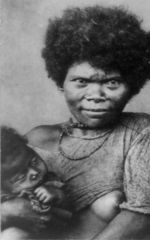The First “Filipinos”
Migration Theory
The first migrants were what Beyer caked the “Dawnmen” (or “cavemen” because they lived in caves.). The Dawnmen resembled Java Man, Peking Man,
and other Asian Home sapiens who existed about 250,000 years ago. They
did not have any knowledge of agriculture, and lived by hunting and fishing. It was precisely in search of food that they came to thePhilippines by way of the land bridges that connected the Philippines and Indonesia. Owing perhaps to their migratory nature, they eventually left the Philippines for destinations unknown.
The second group of migrants was composed of dark-skinned pygmies called “Aetas’ or “Negritoes”. About 30,000 years ago, they crossed the land bridged from Malaya, Borneo, and Australia until
they reached Palawan, Mindoro and Mindanao. They were pygmies who went
around practically naked and were good at hunting, fishing and food
gathering. They used spears and small flint stones weapons.
About 30,000 years ago, they crossed the land bridged from Malaya, Borneo, and Australia until
they reached Palawan, Mindoro and Mindanao. They were pygmies who went
around practically naked and were good at hunting, fishing and food
gathering. They used spears and small flint stones weapons.
 About 30,000 years ago, they crossed the land bridged from Malaya, Borneo, and Australia until
they reached Palawan, Mindoro and Mindanao. They were pygmies who went
around practically naked and were good at hunting, fishing and food
gathering. They used spears and small flint stones weapons.
About 30,000 years ago, they crossed the land bridged from Malaya, Borneo, and Australia until
they reached Palawan, Mindoro and Mindanao. They were pygmies who went
around practically naked and were good at hunting, fishing and food
gathering. They used spears and small flint stones weapons.
The Aetas were already in the Philippines when
the land bridges disappeared due to the thinning of the ice glaciers
and the subsequent increase in seawater level. This natural events
“forced” them to remain in the country and become its first permanent inhabitants.
Because of the disappearance of the
land bridges, the third wave of migrants was necessarily skilled in
seafaring. These were the Indonesians, who came to the islands in boats.
They were more advanced than the Aetas in that: they had tools made out
of stone and steel, which enabled them to build sturdier houses: they
engaged in farming and mining, and used materials made of brass; they wore clothing and other body ornaments.
Last to migrate to the Philippines,
according to Beyer, were Malays. They were believed to have come from
Java, Sumatra, Borneo, and the Malay Peninsula more than 2,000 years
ago. Like the Indonesians, they also traveled in boats.
The Malays were
brown-skinned and of medium height, with straight black hair and flat
noses. Their technology was said to be more advanced than that of their
predecessors. They engaged in pottery, weaving, jewelry making and metal smelting, and introduced the irrigation system in rice planting.
Jocano’s Theory
A human origin-were found in the Tabon Caves of
Palawan by archaeologist Robert Fox and Manuel Santiago, who both
worked for the National Museum. This proves, Jocano argues, that man
came earlier to the Philippines than to the Malay Peninsula; therefore,
the first inhabitants of our islands could not have come from the
region. The “Tabon Man” is said to resemble Java Man and Peking Man. He
gathered fruits, leaves and plants for his food. He hunted with weapons
made of stone. Although further research is still being done on his life
and culture, evidence shows that he was already capable of using his
brain in order to survive and keep himself safe.
Instead of the Migration Theory, Jocano advances the Evolution Theory,
as a better explanation of how our country was first inhabited by human
beings, Jocano believes that the first people of Southeast Asia were
products of a long process of evolution and migration. These people
eventually went their separate ways; some migrated to the Philippines,
the others to New Guinea, Java and Borneo. Proof, Jocano says, can be
found in the fossils discovered in different parts of Southeast Asia, as
well as the recorded migrations of other peoples from the Asian
mainland when history began to unfold.
Walang komento:
Mag-post ng isang Komento